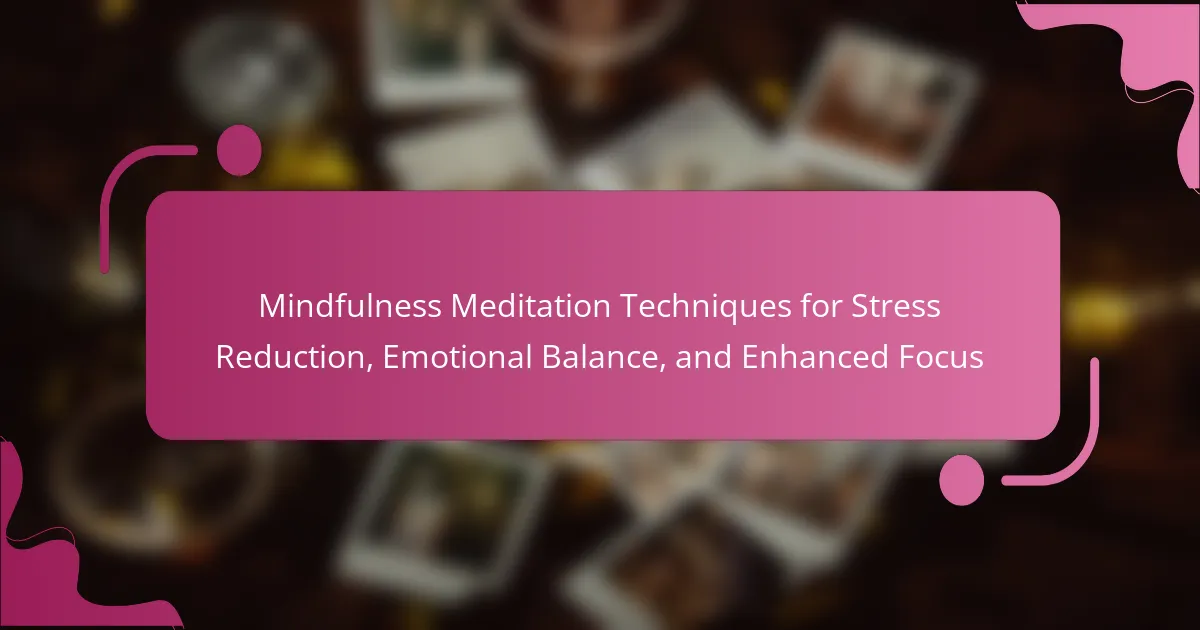Mindfulness meditation techniques offer effective solutions for stress reduction, emotional balance, and enhanced focus. These practices promote relaxation and self-awareness, helping to manage anxiety and improve mood. Techniques like focused breathing and body scans deepen emotional stability while training the mind to remain present enhances concentration. Regular practice fosters resilience against stressors and distractions, leading to improved mental well-being.
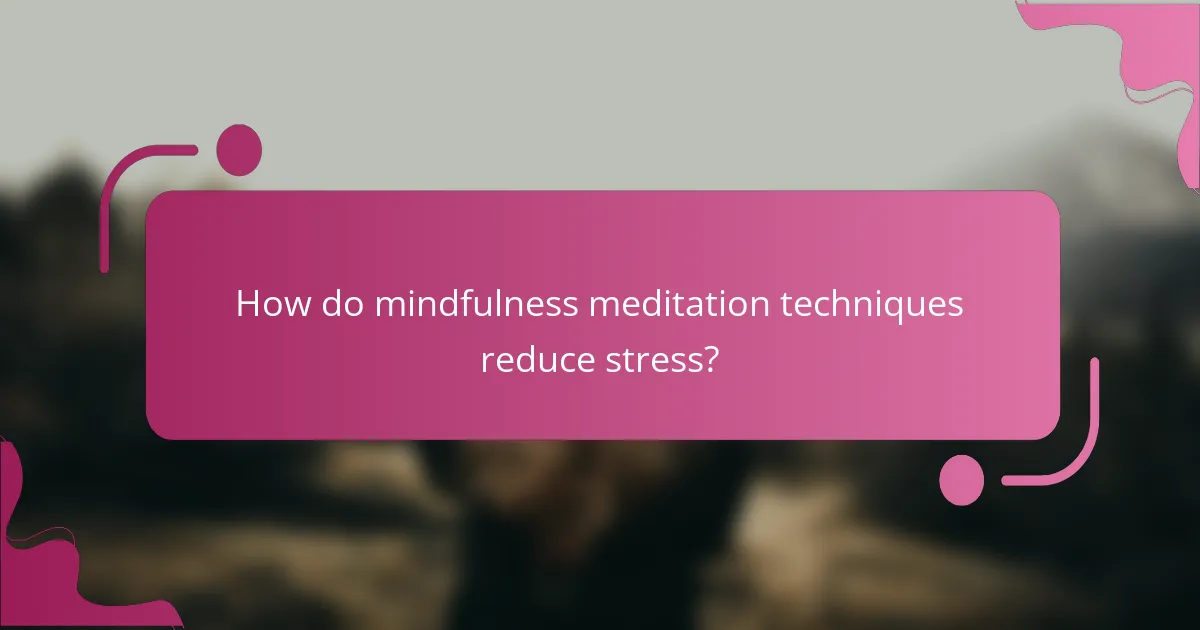
How do mindfulness meditation techniques reduce stress?
Mindfulness meditation techniques effectively reduce stress by promoting relaxation and enhancing emotional regulation. These techniques, such as focused attention and body scan, encourage awareness of the present moment, which can decrease anxiety levels. Research indicates that regular practice can lower cortisol, a stress hormone, and improve overall mental well-being. Mindfulness fosters a unique attribute of emotional balance, allowing individuals to respond to stressors with greater resilience. Additionally, techniques like mindful breathing can enhance focus, further contributing to stress reduction by minimizing distractions.
What physiological changes occur during mindfulness meditation?
Mindfulness meditation induces several physiological changes that enhance mental and physical well-being. These changes include reduced heart rate, decreased blood pressure, and improved respiratory function. Studies show that mindfulness practices can increase gray matter density in brain regions associated with emotional regulation and self-referential processing. As a result, practitioners often experience lower levels of stress and anxiety, leading to greater emotional balance and enhanced focus.
Which mindfulness practices are most effective for stress relief?
Mindfulness practices like focused breathing, body scan, and loving-kindness meditation are effective for stress relief. These techniques enhance emotional balance and improve focus. Focused breathing calms the mind by directing attention to the breath, reducing anxiety. The body scan promotes relaxation by encouraging awareness of physical sensations. Loving-kindness meditation fosters compassion, which can alleviate feelings of isolation and stress. Regular practice of these techniques leads to significant improvements in mental well-being.
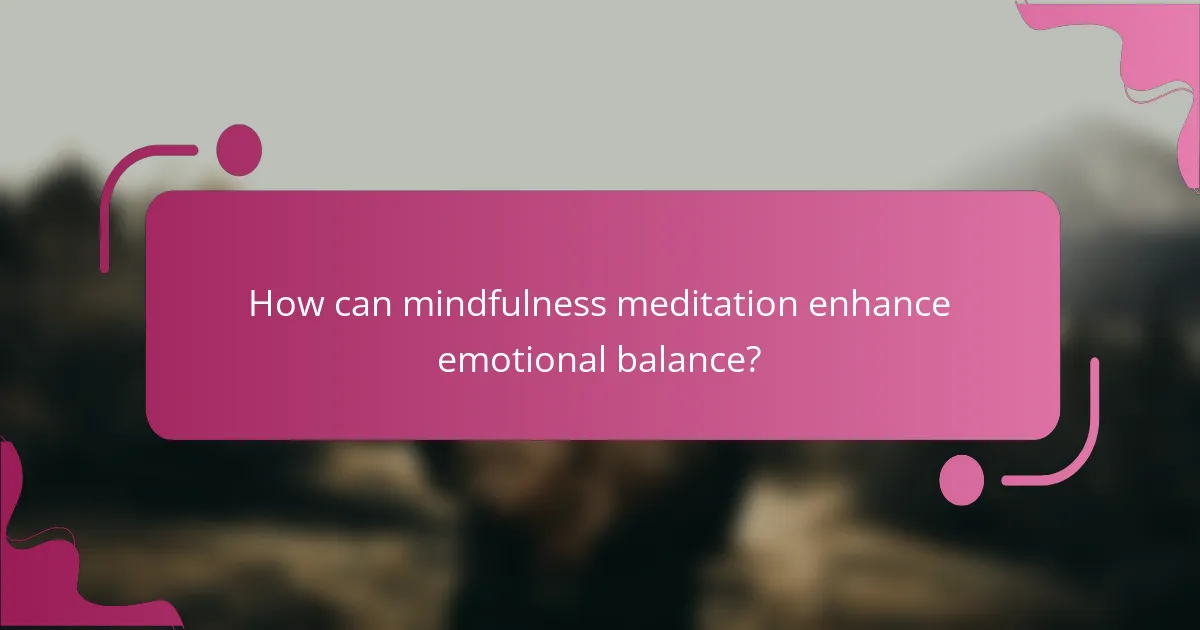
How can mindfulness meditation enhance emotional balance?
Mindfulness meditation enhances emotional balance by promoting self-awareness and reducing stress. Regular practice helps individuals recognize their emotions without judgment, leading to better emotional regulation. Research indicates that mindfulness can decrease anxiety and improve mood, fostering resilience against emotional fluctuations. Techniques such as focused breathing and body scan meditations can further deepen emotional stability, allowing for a more balanced response to life’s challenges.
What role does mindfulness play in emotional regulation?
Mindfulness plays a crucial role in emotional regulation by enhancing awareness and promoting emotional balance. Mindfulness meditation techniques help individuals observe their thoughts and feelings without judgment, leading to reduced stress and improved focus. Research indicates that regular practice can decrease anxiety and increase resilience. Mindfulness fosters a unique attribute of emotional intelligence, enabling better responses to emotional triggers. This practice can also lead to rare benefits, such as a greater sense of well-being and improved interpersonal relationships.
Which mindfulness techniques promote emotional awareness?
Mindfulness techniques that promote emotional awareness include body scan meditation, mindful breathing, and loving-kindness meditation. These practices enhance emotional balance and reduce stress by fostering present-moment awareness and self-compassion.
Body scan meditation encourages awareness of physical sensations, helping individuals identify emotional responses tied to bodily experiences. Mindful breathing focuses attention on the breath, calming the mind and enhancing emotional regulation. Loving-kindness meditation cultivates positive emotions towards oneself and others, promoting emotional resilience.
Research shows that regular practice of these techniques can lead to improved emotional awareness and overall mental well-being. For example, studies indicate that participants practicing mindfulness report higher emotional clarity and reduced anxiety levels.
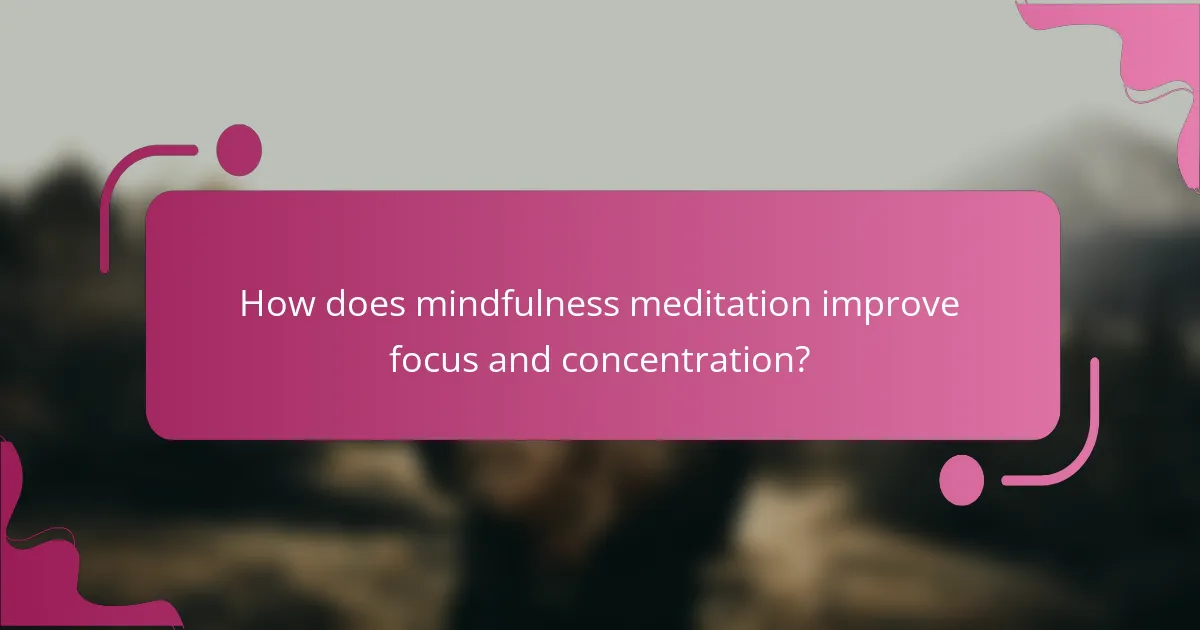
How does mindfulness meditation improve focus and concentration?
Mindfulness meditation significantly enhances focus and concentration by training the mind to remain present. Practicing mindfulness reduces distractions and improves cognitive control, allowing individuals to engage more deeply with tasks. Studies indicate that regular mindfulness practitioners show improved attention spans and greater mental clarity. This technique fosters emotional balance, which further supports sustained concentration.
What cognitive benefits are associated with regular mindfulness practice?
Regular mindfulness practice enhances cognitive benefits such as improved focus, emotional regulation, and reduced stress. Research indicates that consistent meditation can increase gray matter density in areas of the brain associated with memory and emotional control. This neuroplasticity allows individuals to better manage anxiety and maintain a balanced emotional state. Furthermore, mindfulness techniques can enhance attention span and concentration, leading to greater productivity and clarity in thought processes.
Which mindfulness exercises are best for enhancing focus?
Mindfulness exercises that enhance focus include body scan meditation, focused breathing, and mindful walking. These techniques improve attention and reduce distractions.
Body scan meditation involves paying attention to different body parts, promoting relaxation and awareness. Focused breathing emphasizes concentrating on breath patterns, which sharpens mental clarity. Mindful walking combines movement with awareness of surroundings, fostering present-moment focus.
Each technique can be practiced for varying durations, often starting with five to ten minutes. Regular practice cultivates sustained attention and emotional balance, ultimately enhancing overall focus.
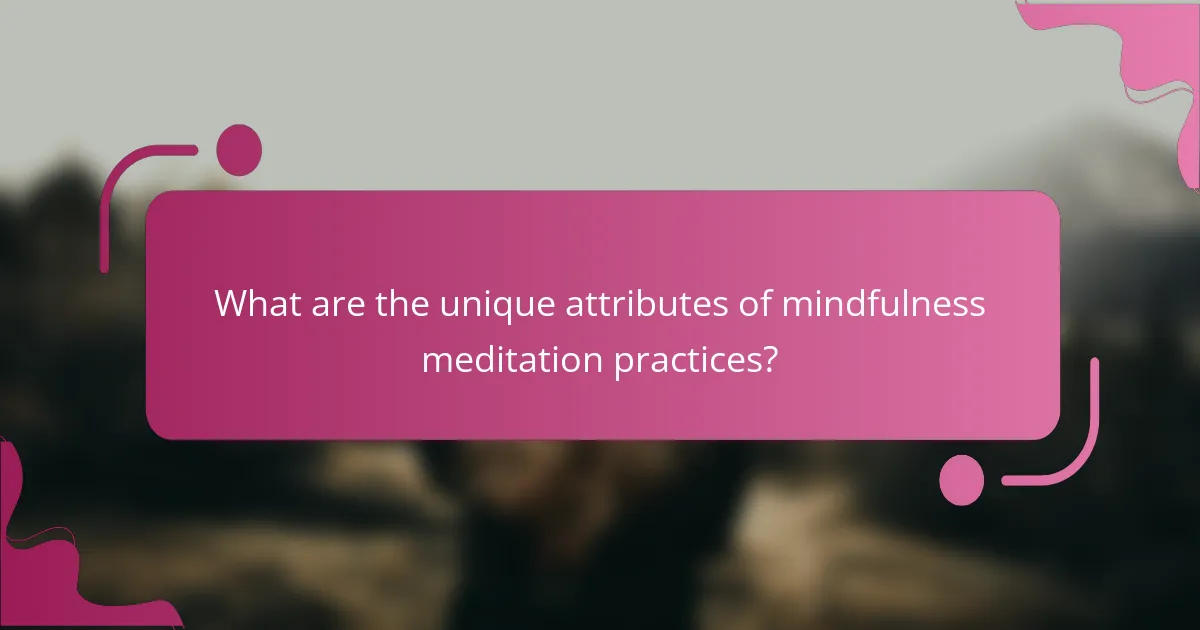
What are the unique attributes of mindfulness meditation practices?
Mindfulness meditation practices uniquely emphasize present-moment awareness, non-judgmental observation, and emotional regulation. These techniques foster stress reduction by promoting relaxation responses, enhancing emotional balance through increased self-awareness, and improving focus via concentrated attention. The practice can be adapted to various forms, such as guided sessions, body scans, or breath awareness, making it accessible to diverse individuals.
How do personal experiences shape mindfulness techniques?
Personal experiences significantly influence mindfulness techniques by tailoring practices to individual needs. People often adapt meditation methods based on their unique stressors, emotional responses, and focus challenges. For instance, someone who experiences anxiety may prioritize breath-focused meditation to cultivate calmness. Conversely, individuals seeking emotional balance might incorporate loving-kindness practices. These adaptations enhance the effectiveness of mindfulness, making it a personalized tool for stress reduction and improved focus. Ultimately, the integration of personal experiences fosters a deeper connection to mindfulness, promoting sustained engagement and positive outcomes.
Which cultural influences impact mindfulness meditation styles?
Cultural influences significantly shape mindfulness meditation styles. Various traditions emphasize different techniques and philosophies, impacting practice and outcomes.
For example, Buddhist traditions focus on awareness and compassion, while Western adaptations often integrate psychological principles. Asian cultures may incorporate movement, such as Tai Chi, while modern practices frequently emphasize breath control and visualization.
The unique attributes of these cultural influences create diverse methods for stress reduction, emotional balance, and enhanced focus, catering to individual preferences and backgrounds. Understanding these influences can enhance the effectiveness of mindfulness practices.

What rare attributes can be found in specific mindfulness meditation techniques?
Certain mindfulness meditation techniques possess rare attributes that enhance their effectiveness. For instance, some techniques incorporate sound frequencies, which can uniquely resonate with specific brainwave patterns, promoting deeper relaxation. Another rare attribute is the integration of biofeedback, allowing practitioners to receive real-time data on their physiological responses, fostering a more personalized experience. Techniques that include guided imagery can also be rare, as they utilize vivid mental visualization to evoke emotional healing. Lastly, some methods may employ unique breath patterns tailored to individual stress responses, providing a distinctive approach to emotional balance.
How do advanced techniques differ from basic practices?
Advanced techniques in mindfulness meditation emphasize deepening awareness and integration, while basic practices focus on initial stress relief and attention training. Advanced methods often incorporate elements like visualization and body scanning, enhancing emotional balance and focus. For instance, techniques such as loving-kindness meditation foster compassion, a unique attribute not typically found in basic practices. As a result, practitioners experience greater emotional resilience and clarity over time, showcasing the rare attribute of sustained mental well-being through advanced techniques.
What exceptional outcomes have been documented in mindfulness research?
Mindfulness research has documented exceptional outcomes such as reduced stress, improved emotional regulation, and enhanced focus. Studies indicate that mindfulness meditation can decrease cortisol levels, leading to lower stress. Participants often report greater emotional balance, with increased resilience to negative emotions. Additionally, enhanced focus and cognitive performance have been observed, supporting better attention management and productivity. These findings underscore the transformative impact of mindfulness practices on mental well-being.
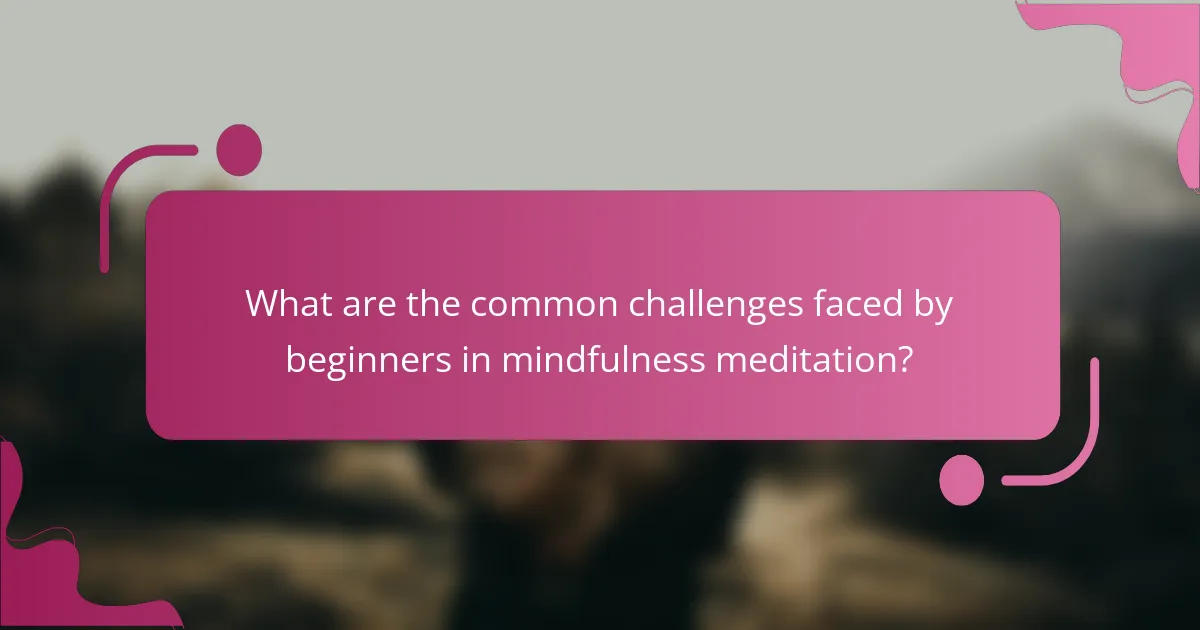
What are the common challenges faced by beginners in mindfulness meditation?
Beginners in mindfulness meditation often face challenges such as difficulty focusing, managing intrusive thoughts, and maintaining consistency in practice. These obstacles can hinder the benefits of stress reduction, emotional balance, and enhanced focus.
One common issue is the wandering mind, where thoughts distract from the present moment. This can lead to frustration and discouragement. Additionally, beginners may struggle with finding a comfortable posture, which impacts their ability to meditate effectively.
Another challenge is the misconception that meditation requires complete silence and stillness. This can create anxiety about not achieving the “ideal” state. Lastly, many beginners find it hard to establish a routine, which is essential for reaping the full benefits of mindfulness meditation.
How can beginners overcome obstacles in their practice?
Beginners can overcome obstacles in mindfulness meditation by establishing a consistent routine, focusing on breath awareness, and practicing self-compassion. Regular practice helps build familiarity and reduces anxiety. Setting realistic goals enhances motivation and progress. Engaging with guided meditations can provide structure and support. Seeking community or a mentor fosters accountability and shared experiences, which can ease feelings of isolation.
What misconceptions about mindfulness meditation should be addressed?
Misconceptions about mindfulness meditation often hinder its effectiveness. Many believe it requires complete silence or an empty mind, when in fact, it’s about acknowledging thoughts without judgment. Others think it’s a quick fix for stress, but consistent practice is essential for lasting benefits. Some individuals assume mindfulness is only for relaxation, overlooking its role in enhancing focus and emotional balance. Additionally, the belief that mindfulness is solely a spiritual practice can deter those seeking practical applications in everyday life.
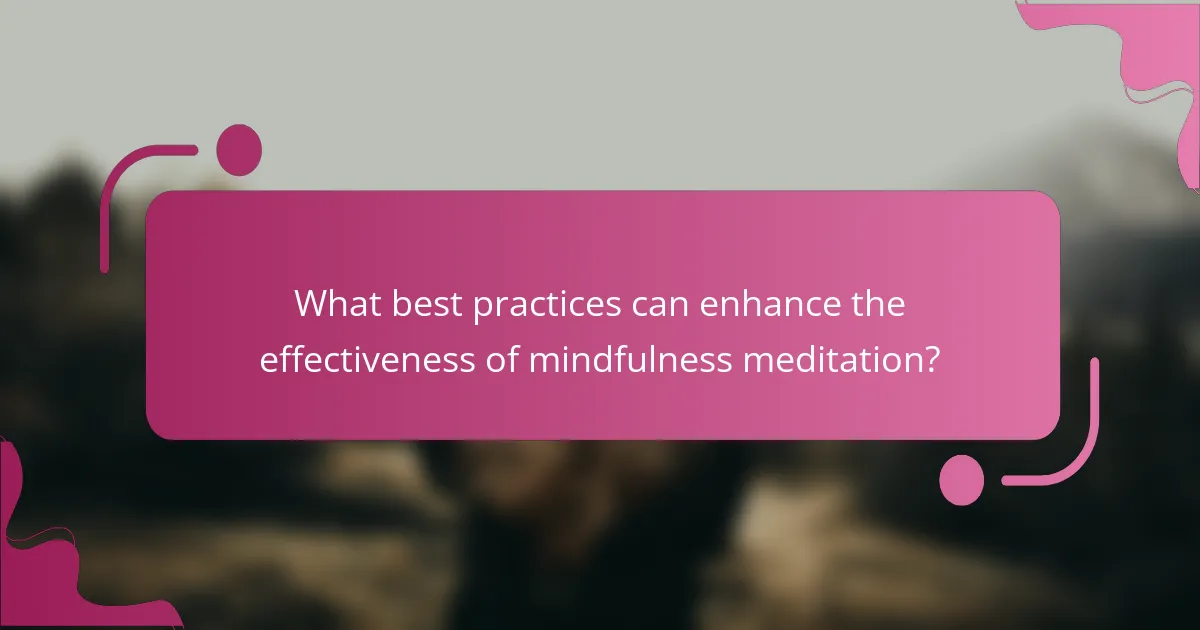
What best practices can enhance the effectiveness of mindfulness meditation?
To enhance the effectiveness of mindfulness meditation, integrate consistent practice, mindful breathing, and a focused environment. Establish a routine by meditating daily for at least 10 minutes. Use deep breathing techniques to anchor your attention, which can improve emotional balance and reduce stress. Create a dedicated space free from distractions to foster concentration and enhance focus.
How can individuals create a conducive environment for meditation?
Individuals can create a conducive environment for meditation by ensuring a quiet, comfortable space free from distractions. Consider these key aspects:
1. Choose a dedicated space that feels peaceful and inviting.
2. Use soft lighting or candles to create a calming atmosphere.
3. Incorporate comfortable seating, such as cushions or chairs.
4. Minimize noise by using soundproofing techniques or playing soft background music.
5. Add elements that promote relaxation, such as plants, essential oils, or calming images.
6. Establish a regular meditation schedule to reinforce the habit.
These steps enhance mindfulness meditation, supporting stress reduction, emotional balance, and improved focus.
What tips do experts recommend for maintaining a consistent practice?
To maintain a consistent mindfulness meditation practice, experts recommend setting a specific time daily, creating a dedicated space, and starting with short sessions. Gradually increase duration as comfort grows. Use guided meditations to enhance focus and structure. Tracking progress can motivate consistency and reinforce commitment.
